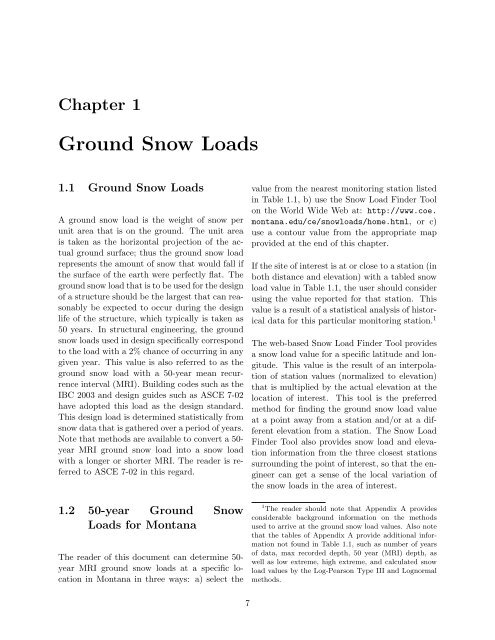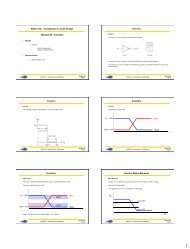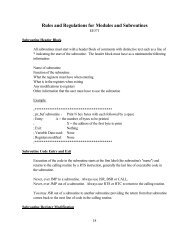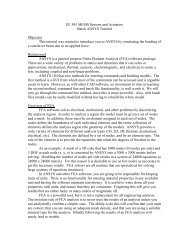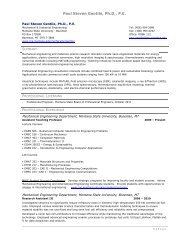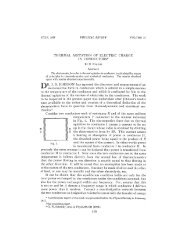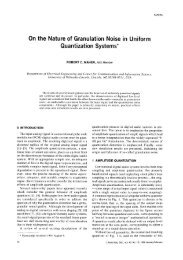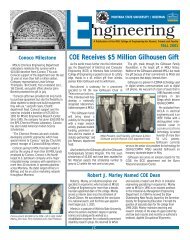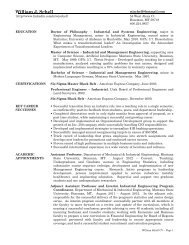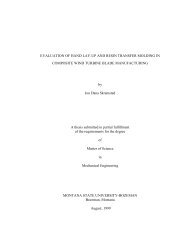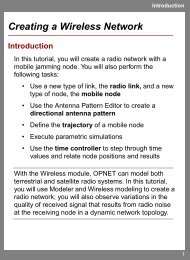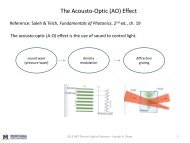Snow Loads for Structural Design in Montana (Revised 2004)
Snow Loads for Structural Design in Montana (Revised 2004)
Snow Loads for Structural Design in Montana (Revised 2004)
Create successful ePaper yourself
Turn your PDF publications into a flip-book with our unique Google optimized e-Paper software.
Chapter 1<br />
Ground <strong>Snow</strong> <strong>Loads</strong><br />
1.1 Ground <strong>Snow</strong> <strong>Loads</strong><br />
A ground snow load is the weight of snow per<br />
unit area that is on the ground. The unit area<br />
is taken as the horizontal projection of the actual<br />
ground surface; thus the ground snow load<br />
represents the amount of snow that would fall if<br />
the surface of the earth were perfectly flat. The<br />
ground snow load that is to be used <strong>for</strong> the design<br />
of a structure should be the largest that can reasonably<br />
be expected to occur dur<strong>in</strong>g the design<br />
life of the structure, which typically is taken as<br />
50 years. In structural eng<strong>in</strong>eer<strong>in</strong>g, the ground<br />
snow loads used <strong>in</strong> design specifically correspond<br />
to the load with a 2% chance of occurr<strong>in</strong>g <strong>in</strong> any<br />
given year. This value is also referred to as the<br />
ground snow load with a 50-year mean recurrence<br />
<strong>in</strong>terval (MRI). Build<strong>in</strong>g codes such as the<br />
IBC 2003 and design guides such as ASCE 7-02<br />
have adopted this load as the design standard.<br />
This design load is determ<strong>in</strong>ed statistically from<br />
snow data that is gathered over a period of years.<br />
Note that methods are available to convert a 50year<br />
MRI ground snow load <strong>in</strong>to a snow load<br />
with a longer or shorter MRI. The reader is referred<br />
to ASCE 7-02 <strong>in</strong> this regard.<br />
1.2 50-year Ground <strong>Snow</strong><br />
<strong>Loads</strong> <strong>for</strong> <strong>Montana</strong><br />
The reader of this document can determ<strong>in</strong>e 50year<br />
MRI ground snow loads at a specific location<br />
<strong>in</strong> <strong>Montana</strong> <strong>in</strong> three ways: a) select the<br />
7<br />
value from the nearest monitor<strong>in</strong>g station listed<br />
<strong>in</strong> Table 1.1, b) use the <strong>Snow</strong> Load F<strong>in</strong>der Tool<br />
on the World Wide Web at: http://www.coe.<br />
montana.edu/ce/snowloads/home.html, or c)<br />
use a contour value from the appropriate map<br />
provided at the end of this chapter.<br />
If the site of <strong>in</strong>terest is at or close to a station (<strong>in</strong><br />
both distance and elevation) with a tabled snow<br />
load value <strong>in</strong> Table 1.1, the user should consider<br />
us<strong>in</strong>g the value reported <strong>for</strong> that station. This<br />
value is a result of a statistical analysis of historical<br />
data <strong>for</strong> this particular monitor<strong>in</strong>g station. 1<br />
The web-based <strong>Snow</strong> Load F<strong>in</strong>der Tool provides<br />
a snow load value <strong>for</strong> a specific latitude and longitude.<br />
This value is the result of an <strong>in</strong>terpolation<br />
of station values (normalized to elevation)<br />
that is multiplied by the actual elevation at the<br />
location of <strong>in</strong>terest. This tool is the preferred<br />
method <strong>for</strong> f<strong>in</strong>d<strong>in</strong>g the ground snow load value<br />
at a po<strong>in</strong>t away from a station and/or at a different<br />
elevation from a station. The <strong>Snow</strong> Load<br />
F<strong>in</strong>der Tool also provides snow load and elevation<br />
<strong>in</strong><strong>for</strong>mation from the three closest stations<br />
surround<strong>in</strong>g the po<strong>in</strong>t of <strong>in</strong>terest, so that the eng<strong>in</strong>eer<br />
can get a sense of the local variation of<br />
the snow loads <strong>in</strong> the area of <strong>in</strong>terest.<br />
1 The reader should note that Appendix A provides<br />
considerable background <strong>in</strong><strong>for</strong>mation on the methods<br />
used to arrive at the ground snow load values. Also note<br />
that the tables of Appendix A provide additional <strong>in</strong><strong>for</strong>mation<br />
not found <strong>in</strong> Table 1.1, such as number of years<br />
of data, max recorded depth, 50 year (MRI) depth, as<br />
well as low extreme, high extreme, and calculated snow<br />
load values by the Log-Pearson Type III and Lognormal<br />
methods.


